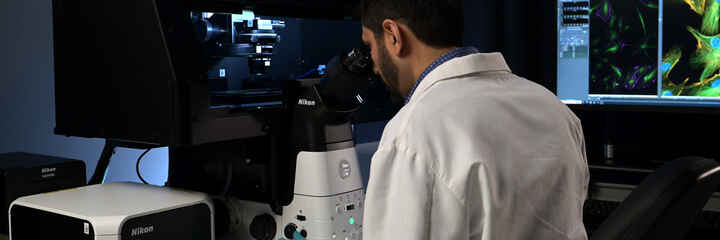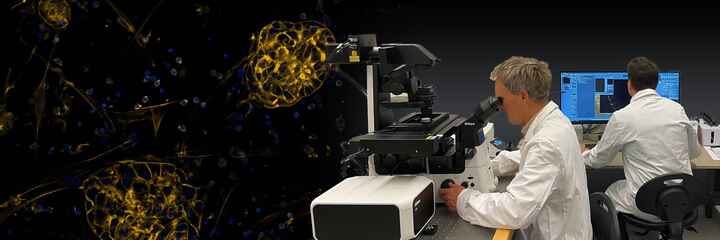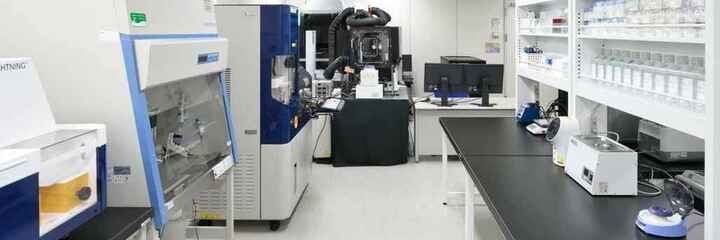News
Mouse Embryo Captures Top Honors At Nikon Small World
Oct 5, 2007
- Explorers Club Hosts Top Photomicrographs from Across the World - - Museum Tour Launches in October -

From a background of blackness emerges a peaceful image of bright red and green - a double transgenic mouse embryo - this year's winning entry in the Nikon Small World Photomicrography Competition. The image was captured by Gloria Kwon, a researcher at the Memorial Sloan Kettering Institute, using widefield microscopy and red and green fluorescence.
Nikon Small World recognizes Kwon's image, along with the other 2007 winners, for depicting both scientific and artistic qualities, illustrating proficiencies in both areas. The winning images were selected from over 1,700 photomicrograph entries from scientists and artists from around the globe and judged by a panel of experts.
"Nikon Small World provides the opportunity for the general public to experience the beauty that can be generated through scientific research," said Lee Shuett, executive vice president, Nikon Instruments. "As digital imaging capabilities continue to advance, our abilities to capture and share the tiniest of objects continue to grow. We celebrate every Small World contributor as we honor the 2007 winners."
Founded in 1974 to recognize excellence in photography through the microscope, Nikon Small World is the leading forum for celebrating the beauty and complexity of objects seen through the light microscope. The 2007 winning photographers were recognized last night at the Explorers Club in New York City, a famed meeting point and unifying force for explorers and scientists worldwide. Nikon also unveiled the complete gallery of winning photomicrographs set to tour science and art museums across the nation beginning October 12. Images are also available in the Small World calendar, which can be purchased at http://www.nikonsmallworld.com..., and in an online gallery featured at the same location.
The top three images include Kwon's image of the mouse embryo, Michael Hendricks' image of a zebrafish brain cross-section and Wim van Egmond's image of a rotifer, a microscopic marine animal. Nikon has also awarded several "Images of Distinction" this year to outstanding photomicrographs that demonstrate superior technical competency and artistic skill.
"Each image offers a glimpse into an unseen world," said Eric Flem, communications manager, Nikon Instruments. "From viewing the smallest specimens to uncovering new levels of detail, these images broaden our understanding of how everything is connected."
This year's judges again represented top industry experts and included Thomas Deerinck, research scientist, National Center for Microscopy and Imaging Research and the Center for Research on Biological Systems at the University of California, San Diego; Nicole Dyer, senior editor, Popular Science; John Hart, atmospheric and oceanic science professor, University of Colorado, Boulder; Malcolm Ritter, science writer, Associated Press; and Daniel Sieberg, science and technology correspondent, CBS News. Michael Davidson, Director of the Optical and Magneto-Optical Imaging Center at the National High Magnetic Field Laboratory at Florida State University served as a consultant to the judges.
THE OFFICIAL 2007 NIKON SMALL WORLD WINNERS
The 2007 gallery of winning images can be viewed at http://www.nikonsmallworld.com....
1st Place
Gloria Kwon
Memorial Sloan-Kettering Institute
New York, New York, USA
Double transgenic mouse embryo, 18.5 days (17x)
Brightfield, Darkfield, Fluorescence (GFP, RFP)
2nd Place
Michael Hendricks
Temasek Life Sciences Laboratory
National University of Singapore
Kent Ridge, Singapore
Zebrafish embryo midbrain and diencephalon (20x)
Confocal
3rd Place
Wim van Egmond
Micropolitan Museum
Rotterdam, The Netherlands
Testudinella patina (a rotifer) (400x)
Differential Interference Contrast
4th Place
Charles Krebs
Charles Krebs Photography
Issaquah, Washington, USA
Marine diatoms attached to Polysiphonia (red algae) (100x)
Differential Interference Contrast
5th Place
Peter Parks
Imagequestmarine.com
Witney, Oxon, UK
Sea water with mixed zooplankton and needle eye (20x)
Reflected Light
6th Place
Charles Krebs
Charles Krebs Photography
Issaquah, Washington, USA
Hydrophilidae sp. (water scavenger beetle) larva (100x)
Brightfield with Crossed Polarization
7th Place
Michael Klymkowsky
MCD Biology
University of Colorado at Boulder
Boulder, Colorado, USA
Xenopus (frog) embryos (20x)
Stereomicroscopy
8th Place
Vera Hunnekuhl
Department of Zoology
University of Osnabruck
Osnabruck, Germany
Erpobdella octoculata (fresh water leech) (25x)
Confocal
9th Place
Shamuel Silberman
Ramat Gan, Israel
Papaver subpiriforme (corn poppies) flower bud (20x)
Fiber Optic Illumination
10th Place
Dr. Stephen Nagy
Montana Diatoms
Helena, Montana, USA
Antique microscope slide featuring thin section of diseased ivory (15x)
Polarized Light
11th Place
Dr. Robert Markus
Institute of Genetics
Biological Research Center of the Hungarian Academy of Sciences
Szeged, Hungary
Opening stamen of Mirabilis jalapa (flower) (125x)
Confocal
12th Place
Annette Bergter
Zoology Division
University of Osnabruck
Osnabruck, Germany
Ophryotrocha diadema (marine worm) embryo, showing nervous system and
cilia (25x)
Confocal
13th Place
Dr. Stephen Lowry
University of Ulster
Coleraine, Northern Ireland, UK
Coiled radula of Patella vulgaris (mollusk) (20x)
Polarized Light
14th Place
Christian Gautier
BIOS/PHONE Photo Agency
Avignon, France
Cedrus atlantica (cedar) leaf crosscut (200x)
Polarized Light
15th Place
Rodrigo Mexas
Oswaldo Cruz Foundation
Rio de Janeiro, Brazil
Trematode sp. (parasitic worm) (400x)
Differential Interference Contrast
16th Place
Steven Valley
Oregon Department of Agriculture, Plant Division
Salem, Oregon, USA
Mimetidae sp. (spider) egg case (30x)
Stereomicroscopy
17th Place
Dr. Jeffery Bowen
Bridgewater State College
Bridgewater, Massachusetts, USA
Kaleidofly of a Halloween Pennant (dragonfly) (1x)
Stereomicroscopy
18th Place
Klaus Bolte
Natural Resources Canada
Ottawa, Ontario, Canada
Amisega floridensis (parasitic wasp) (90x)
Stereomicroscopy
19th Place
Viktor Sykora
Institute of Pathophysiology, First Medical Faculty
Charles UniversityPrague, Czech Republic
Epilobium parviflorum (small-flowered willowherb) seeds (10x)
Stereomicroscopy, Darkfield
20th Place
Dr. Matthew Hooge
Portland, Oregon, USA
Clione sp. (planktonic mollusk) larva (40x)
Differential Interference Contrast
HONORABLE MENTIONS
Jesper Gronne
Silkeborg, Denmark
Cluster of snow crystals (snowflakes) (10x)
Polarized Light
Vera Hunnekuhl
Department of Zoology
University of Osnabruck
Osnabruck, Germany
Erpobdella octoculata (fresh water leech) (10x)
Confocal
Dr. Daniel Kalman (Emory University)
Patrick Reeves (Emory University)
Katie Ris-Vicari (Nature Medicine)
Cell infected with poxvirus (630x)
Deconvolution
Rafal Klajn
Department of Chemical Engineering
Northwestern University
Evanston, Illinois, USA
Liesegang rings obtained by reacting silver and dichromate ions (40x)
Brightfield
Milan Kosanovic
Belgrade, Serbia
Evaporated copper-sulphate solution on paper figure (1x)
Polarized Light
Dr. Pascale Lacor
Northwestern University
Evanston, Illinois, USA
Mature rat hippocampal neurons attacked by Alzheimer's related neurotoxins
(100x)
Confocal
Carmen Laethem
Aerie Pharmaceuticals
Research Triangle Park, North Carolina, USA
Trabecular meshwork cells from a pig's eye (20x)
Fluorescence
Rudolf Oldenbourg
Marine Biological Laboratory
Woods Hole, Massachusetts, USA
Nephrotoma suturalis (crane fly) spermatocytes (60x)
Polarized Light
Dr. Shirley Owens
Center for Advanced Microscopy
Michigan State University
East Lansing, Michigan, USA
Cichorium intybus (chickory) pollen grains on
stigmatic surface (1250x)
Confocal, Fluorescence
Peter Parks
Imagequestmarine.com
Witney, Oxon, UK
Atlanta peronii (gastropod mollusk) (170x)
Darkfield, Rheinberg Illumination
Daniel Pregibon
Massachusetts Institute of Technology
Cambridge, Massachusetts, USA
Particles used to detect multiple DNA oligomers (100x)
Fluorescence
Dr. Havi Sarfaty
Ramat Gan, Israel
Desiccated garden flower (20x)
Fiber Optic Illumination
Dr. Jan Schmoranzer
Columbia University
New York, New York, USA
Wounded monolayer of fibroblast cells in culture (600x)
Fluorescence
Viktor Sykora
Institute of Pathophysiology, First Medical Faculty
Charles UniversityPrague, Czech Republic
Infested leaf (5x)
Stereomicroscopy, Darkfield
Sven Terclavers
VIB Center for Transgene Technology & Gene Therapy
Campus Gasthuisberg O&N
Leuven, Belgium
3D reconstruction of a zebrafish section (400x)
Confocal (2-photon)
Bob Turner, RBP, FBPA
The Scripps Research Institute
La Jolla, California, USA
Quartz sample (20x)
Interference Cross Polarization
ABOUT THE NIKON SMALL WORLD PHOTOMICROGRAPHY COMPETITION
The Nikon Small World Photomicrography Competition is open to anyone with an interest in photography. Participants may submit their images in traditional 35mm format, or upload digital images directly at http://www.nikonsmallworld.com.... The first and second of 20 prize winners will receive a selection of Nikon products and equipment worth $3,000 and $2,000 respectively. For additional information, contact Nikon Small World, Nikon Instruments Inc., 1300 Walt Whitman Road, Melville, NY 11747, USA or phone (631) 547-8569. Entry forms for Nikon's 2007 Small World Competition may also be downloaded from http://www.nikonsmallworld.com...



